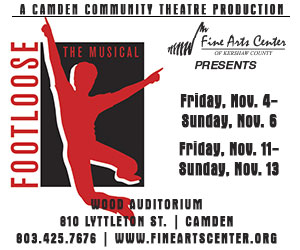American Gun is in Therapy
By Kyle Petersen
One of the songs on the backend of American Gun’s new album Therapy, released May 10, 2011, is about the joys and travails of being in a local rock band—and it’s called, in a somewhat tongue-in-cheek fashion, “Breakin’ Up.” It’s a sneering punk-rock tune, full of careening guitars and a biting cynicism about band mates, club dates, and alcohol. But halfway through the song, something striking happens. In the space of a just a few beats, the guitars fall out and the drums go from pummeling forward to marking out a muscular half-time groove that lifts the tune from a sweaty barroom into the rock and roll arena. The instruments build the song back up again, eventually renewing their lunge forward with a new purpose. Lead singer Todd Mathis goes from bemoaning his problems to elegantly summarizing the whole reason for this venture. “But you keep going forward because it’s all you know to do/ the music makes you happy, nothing else is true” he sings, half full of desperation, half full of a blind assuredness that this is, in fact, what he is meant to be doing.
Any band is almost defying the odds just by releasing a fourth album. As “Breakin’ Up” suggests, rock bands face a unique set of challenges and problems in staying together. Rock music is often a dangerous cocktail of rebellion, alcohol, and personal expression that makes for rather volatile situations. True to form, American Gun has seen members come and go; causing the music to shift and evolve in an effort to maintain the delicate balance that keeps the engine running.
The group started out in 2004 with the stated purpose of writing “three chord songs you could get drunk to” and quickly became Columbia’s go-to alt. country band. They released two LPs, Dark Southern Hearts in 2006 and The Means and the Machine in 2008, that mixed stone-cold rockers with tear-in-your-beer heart-jerkers and borrowed the talents of a bevy of outside musicians and producers, most notably pedal steel player Al Perkins, who has played with Bob Dylan, Garth Brooks, and The Flying Burrito Brothers; and Chris Stamey, who has worked with both Alex Chilton and Whiskeytown. The band toured throughout the Southeast, flirted with a number of regional record labels, and even got a few songs licensed to cable television shows. Still, the going was hard. Two thousand nine saw the group changing up guitarists and adding and subtracting a keyboard player, and, following the release of their third LP Devil Showed Me His Hand, the departure of co-leader Donald Merckle.
Merckle’s departure, as disappointing as it was, pushed the band in new directions. In tandem with the songwriter’s leaving was the arrival of local record producer and engineer Paul Bodamer, who began serving as an unofficial “fifth member” and what drummer Andrew Hoose refers to as the “catalyst” for the new record. Bodamer himself describes his role as merely pushing a different approach to arrangements and vocals in a new direction, and providing some technical expertise—things like “figuring out tone, whether you want the guitars to be dark or bright on a particular song, what snare to use, what cymbals to use—subtle things that serve the particular song.”
Bodamer’s tech-savvy approach to recording and energetic enthusiasm for the band pushed the m embers to try new creative approaches. “This was the most pre-production we’ve ever done,” Mathis says. “His level of expertise, as far as engineering and stuff, and creating really well-done pre-production recordings, made a big difference on this record.” Bodamer went out of his way to talk to each band member individually, which they all agree was a big part in making the new record more of a “straight-up rock and roll record” than they had in the past. “It sounds exactly like the four of us,” lead guitarist Noel Rodgers says, the pride made clear in his voice. “If you don’t sound like who you are at this point [in your thirties], you’ve missed something along the way.”
This subtle stylistic change-up was something of a conscious decision, as the group was determined to present a more “honest” document of the band this time around. “It was the idea early on, to have an album unlike our other albums, where half the songs we didn’t want to play live,” says bassist Kevin Kimbrell. Rodgers concurs. “A lot of times we would find ourselves trying to twang up something and Paul would say ‘Stop! You are being a great rock band right now. Just be a great rock band!’” This input and approach, along with the extensive pre-production, gave the record a different bent from the start.
Pre-production kind of seems like a pseudo-professional term for “band practice,” but what it really means is “band practice for making a record.” In this case, during the spring and summer of 2010 as the band was hashing out some new tunes, Bodamer set up a makeshift recording room in the band’s practice space in the Rosewood area of Columbia so they could play the music back and shape songs more constructively. “We did a lot of recordings, and a lot of listening and thinking back on it,” which was something new, says Kimbrell. This approach freed up the band to both have “Todd walk in with a chord progression and lyrics and, by the end of practice, have a badass song,” says Rodgers, remembering the creation of the album’s title cut “Therapy.”
This freedom also meant the group could re-imagine and try different approaches to tunes like “Movin’ Down the Line.” The song was brought in with Mathis’s sole directive to make sure it did not turn out “a white boy blues song.” After several attempts at finding a satisfying arrangement, the band was almost ready to discard the song. However, the next practice Kimbrell came across a fuzz-toned bass line that locked in perfectly with the mid-tempo rock groove Hoose was playing at the time. Bodamer lit up at this casual creation, and the band began re-building the song around it. The end result is a dark, noisy tune that owes as much to Tom Waits and Black Rebel Motorcycle Club as it does to rowdy Southern rockers like Lucero and the Drive-by Truckers.
On the whole, Merckle’s departure also had another unexpected benefit in opening up new space in the band’s sound. While all of the band members will attest to the songwriting chops and talent their former co-leader brought to the band, his acoustic guitar presence “cut out a lot of the high-end stuff that me and Kevin are doing,” as Noel points out. Kimbrell and Hoose also felt somewhat tethered rhythmically by his style. “We just sonically have more space,” Kimbrell explains.
Propelled by this new approach and Bodamer’s gentle prodding, the band geared up for another first—an out-of-town, around-the-clock recording session at the Fidelitorium in Winston-Salem, North Carolina. The recording setting was another of Bodamer’s ideas—he had already built a relationship with Mitch Easter, the studio owner and legendary musician and producer behind the classic early R.E.M. records Murmur and Reckoning. Part of the decision was purely technical – the drum sounds in a big room like the Fidelitorium are a definite plus – but there were other advantages as well. The band could really spread out in the large recording space, and having a separate hang-out room helped defuse any tension or sense of being cooped up. Easter’s role as a second engineer meant a living recording legend, with all of his accompanying gear, was making a significant contribution to things like guitar tone (also Easter ultimately ended up laying a guitar solo on the rambling country-rock tune “1500 Jessicas”).
The band would come out of the weekend with 11 songs largely completed, with just the vocals left to be recorded in Bodamer’s home studio and a few tracks awaiting organ and keys overdubs. Most of the credit for this goes to the pre-production approach, since the band laid so much of the important groundwork down ahead of the recording time.
When asked about their ambitions for the record, the band laughs at the long odds of becoming a big rock band. Mathis remains optimistic about the licensing possibilities for his music, but puts the emphasis on the fact that “this is what I like to do. I like making records in general. I like hanging out with these guys and, whatever we come up with, if it’s good, I want to record it.” He also asks of listeners new and old that “whatever you’ve heard about American Gun before, just toss it out the window. This is what we sound like now.”






.jpg)
This article, along with many others, has been republished here on the What Jasper Said blog in an attempt to re-appropriate ownership of the article to it’s legal owner. Over the past week, this article, again with many others, was illegally published — with no credit given to the author — on another local website. Upon inquiring with several attorneys, Jasper was unanimously informed that the other website has no ownership of the art materials published there and that the other website is, indeed, breaking the law by publishing the art materials as its own. A friendly letter to the owner of the other website asking him to remove the art material not belonging to him was ignored. Instead, even more articles to which he does not own the copyright were illegally added to his collection. We do not want to have to take legal actions. We had rather put our energy into giving the community an excellent arts magazine. That said, publishing someone else’s written word without their permission is illegal. Publishing it without giving them credit is despicable.